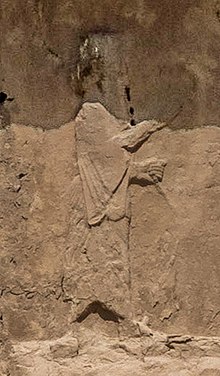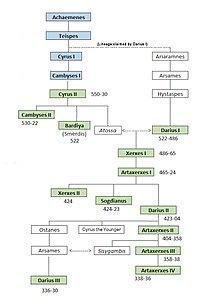
Back دارا الثاني Arabic داريوس التانى ARZ II Dara Azerbaijani Дарий II Bulgarian Darios II Catalan Dareios II. Czech Darius II, brenin Persia Welsh Dareios II. German Δαρείος Β΄ της Περσίας Greek Dario la 2-a Esperanto
| Darius II 𐎭𐎠𐎼𐎹𐎺𐎢𐏁 | |
|---|---|
 Darius II as depicted on his tomb in Naqsh-e Rostam | |
| King of Kings of the Achaemenid Empire | |
| Reign | 423–404 BC |
| Predecessor | Sogdianus |
| Successor | Artaxerxes II |
| Pharaoh of Egypt | |
| Reign | 423–404 BC |
| Predecessor | Sogdianus |
| Successor | Amyrtaeus |
| Died | 404 BC |
| Spouse | Parysatis |
| Issue | |
| Dynasty | Achaemenid |
| Father | Artaxerxes I |
| Mother | Cosmartidene of Babylon |
| Religion | Zoroastrianism |
Darius II (Old Persian: 𐎭𐎠𐎼𐎹𐎺𐎢𐏁 Dārayavaʰuš; Ancient Greek: Δαρεῖος Dareios), also known by his given name Ochus (Greek: Ὦχος Ochos), was King of Kings of the Achaemenid Empire from 423 BC to 405[1] or 404 BC.[2]
Following the death of Artaxerxes I, in 424 BC or 423 BC, there was a struggle for power between his sons. The victor, Ochus, adopted the name Darius (Greek sources often call him Darius Nothos, "Bastard").[3] His reign was marked by a series of revolts by various satraps and involvement in the Greek Peloponnesian War.

It seems that Darius II was quite dependent on his wife Parysatis. In excerpts from Ctesias some harem intrigues are recorded, in which he played a disreputable part.[2] The Elephantine papyri mention Darius II as a contemporary of the high priest Johanan of Ezra 6:10.[4][5] Darius II is potentially mentioned in the books of Haggai, Zechariah, and Ezra–Nehemiah of the Hebrew Bible (the Christian Old Testament). There is some debate on whether these books refer to Darius the Great though.
- ^ Brill's New Pauly, "Darius".
- ^ a b One or more of the preceding sentences incorporates text from a publication now in the public domain: Meyer, Eduard (1911). "Darius". In Chisholm, Hugh (ed.). Encyclopædia Britannica. Vol. 7 (11th ed.). Cambridge University Press. p. 833.
- ^ Stolper, Matthew W. (1985). Entrepreneurs and empire: the Muras̆û Archive, the Muras̆û Firm, and Persian rule in Babylonia. Uitgaven van het Nederlands Historisch-Archaeologisch Instituut te Istanbul = Publications de l'Institut historique et archéologique néerlandais de Stamboul. Istanbul: Nederlands Historisch-Archaeologisch Instituut te Istanbul. pp. 118–120. ISBN 978-90-6258-054-5.
- ^ Pritchard, James B. ed., Ancient Near Eastern Texts Relating to the Old Testament, Princeton University Press, third edition with supplement 1969, p. 492
- ^ Bezalel Porten (Author), J. J. Farber (Author), C. J. F. Martin (Author), G. Vittmann (Author), The Elephantine Papyri in English (Documenta Et Monumenta Orientis Antiqui, book 22), Koninklijke Brill NV, The Netherlands, 1996, p 125-153.